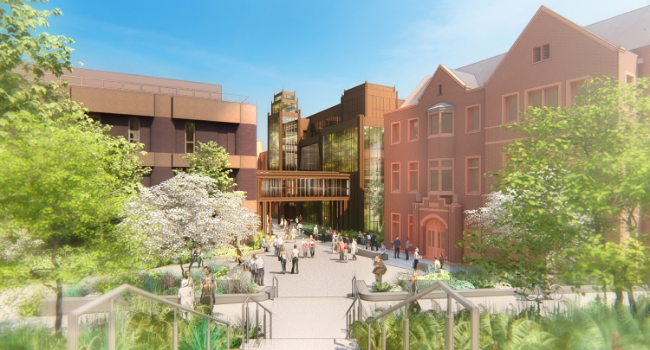
Transformed Yale Peabody Museum Reopens in Stunning Style
- By Bill Shaughnessy
- October 14, 2024
Emerging from a major four-year renovation, the reimagined Yale Peabody Museum of Natural History has reopened its doors to the delight of the citizens of its longtime home in New Haven, Connecticut and the many visitors, students, and researchers who come to explore and learn about its breathtaking collections and fascinating exhibitions.
According to their website, “The Peabody Museum has been part of Yale and New Haven for more than 150 years. In the 19th century it was the science startup of its day.” Since 1925, the museum’s French Gothic brick and dark brownstone building has been the habitat for its treasures. And while the science of evolution within it continued to attract more than 130,000 visitors every year, it was apparent that additional exhibit and study space was long overdue.
Evolving to Greet the Future
Based on a decade of master planning by Yale University and Centerbrook Architects and Planners, construction began in 2020 on over 172,000 square feet of improvements, including a nearly 58,000-square-foot, four story infill addition that now expands the museum and connects it to the university’s environmental science center.
The museum’s awe-inspiring collections of the natural world form the foundation of the holistic design encompassing the Peabody’s extensive transformation. From bright new galleries, expanded classroom space, and compelling exhibits to the new building, every part of the renovation reflects the museum’s natural history and gothic architectural heritage – right down to the door hardware.
Inspired Design Inspires
Specific details of the museum’s contents and surroundings are at the heart of Centerbrook’s design and extend all the way to the Peabody’s custom door hardware, a creative collaboration between ASSA ABLOY and Centerbrook, led by Mark Simon, FAIA and principal at the architectural firm.
Simon describes how it started. “As is the case with most design, you’re never quite sure where you’re going to end up when you start. You just hope you’ve got a really good relationship with the people around you that you’re working with, and that’s what happened here.”
“Mark came in and was admiring all the door hardware we have available,” explains Sandy Matheny, Director of Decorative Openings, ASSA ABLOY. “We quickly learned what an extraordinary opportunity the Peabody was going to be.”
David Skelly, Director of the Peabody, further explains, “Very early on in the design process, Mark came to me and said he wanted to develop door handles that reflected the essence of the museum in a way that would make people look at them and get ‘that’s a Peabody door handle!’”
“That inspired me to think maybe we should have something that looks and feels natural,” adds Simon. “This is the Peabody Museum of Natural History after all. People simply function better when they feel a connection to nature. And that includes everything from having large windows and seeing outside to fine details like this.”
Matheny shares why a custom approach matters. “Door hardware can be one of the most intimate points of contact we have with a space. Because Mark’s inspiration called for a unique, organic design, custom hardware was the obvious approach.”
For the Peabody, Osteo-Architecture may best describe the inspiration behind the design of the lever and pull that accentuate the doorways.
According to Simon, “We brainstormed with ASSA ABLOY and decided to cast the door levers in brass. That gives them a weighty, substantial feel. They have a sculptural quality that conforms to the palm of the hand, and the grip features a subtle thumbprint detail.”
The lever is part of the trim for the SARGENT mechanical lock, access control, and exit devices that contractors installed throughout the museum. There’s also a Rockwood door pull that complements the lever, which features an elliptical grip at a slight angle that also incorporates the thumbprint detail for continuity. All the door hardware has a custom dark bronze finish specified to match the aluminum storefront and interior framing systems.
Simon is thrilled with how it all turned out, “The nice thing about this hardware is shows up on both sides of over 200 doors at all the different places in the museum old and new. It ties the whole thing together.”
David Skelly agrees, “Anything that people touch and see and feel—the exhibits and everything around them—are absolutely part of the experience that ignites people’s curiosity and gets them in a mode to want to learn more.” He adds, “The handles and pulls look like they have a connection to a fossil or bone artifact…facets like the rounded shape…that’s what we see in nature. Mark, Centerbrook, ASSA ABLOY, everyone did a beautiful job.”
Good Design Award
“Working together with ASSA ABLOY on the custom door hardware was effortless,” says Simon. “I was astonished how open to ideas they were. We’re delighted it won the Good Design Award. How something feels in your hand is a sense many architects often forget about. I’m glad we didn’t.”
You might say it was simply a natural fit for such a landmark renovation.